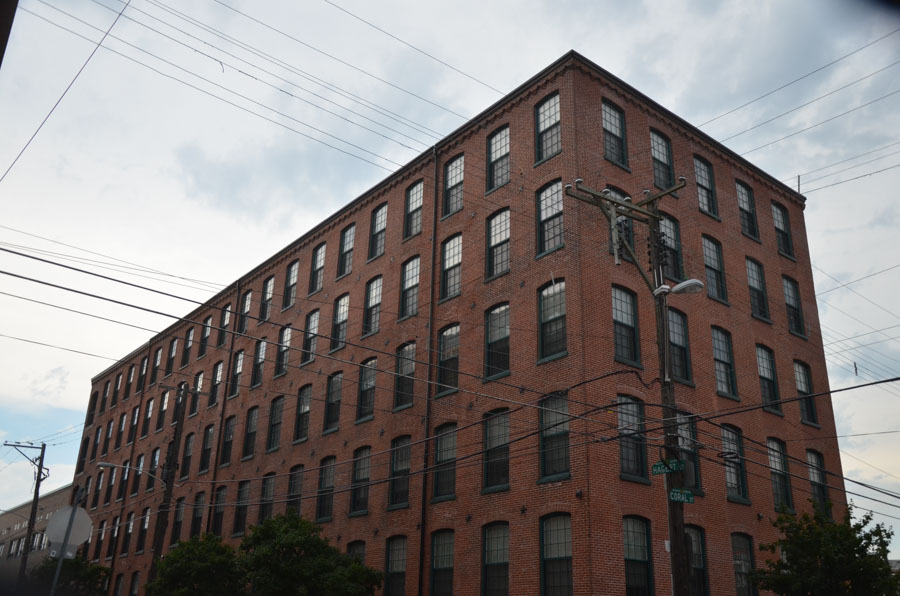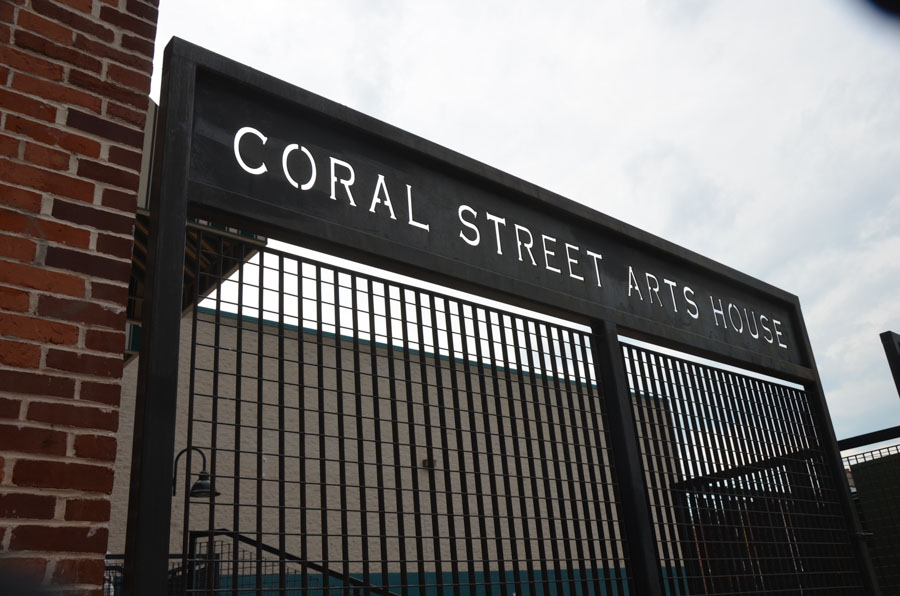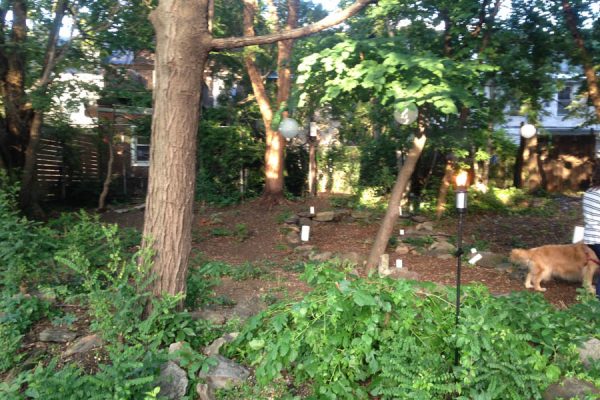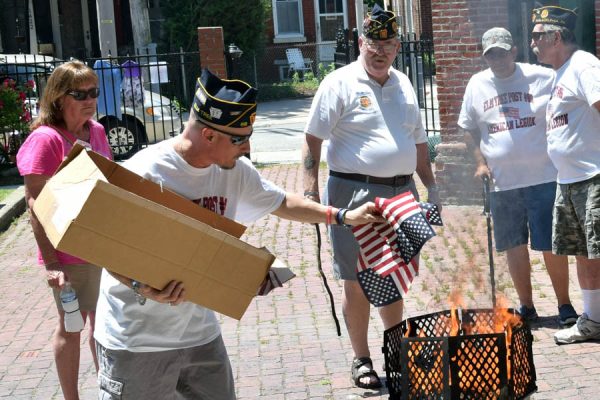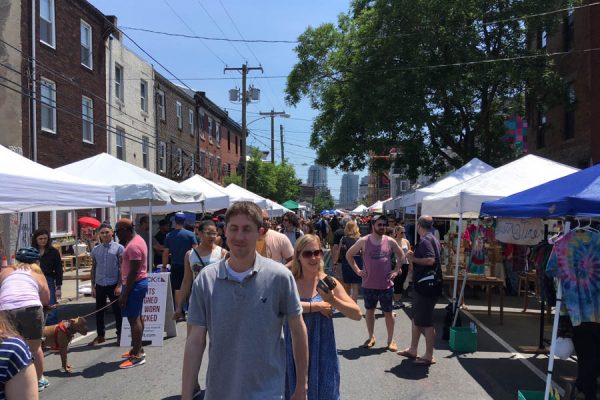This Arts House: Celebrating 10 Years at the Coral Street Arts House
“Go get the picture of it for me,” Sandy Salzman calls over to Ed McColly. Salzman is the Executive Director of New Kensington Community Development Corporation (NKCDC) and McColly is an NKCDC Real Estate Development Associate.
After a few moments pass, Ed walks through the door with a tattered flier dated September 27, 2003, deeming the property at 2434 Coral Street in East Kensington dangerous and unfit for human occupancy, ordering it either to be demolished or repaired. After a year of planning, this is how Coral Street Arts House, the rehabbed East Kensington factory turned low income living space for artists we happen to be seated in, almost never happened.

This notice dated September 27, 2003, deeming the property at 2434 Coral Street in East Kensington dangerous and unfit for human occupancy, ordering it either to be demolished or repaired.
Now, Coral Street Arts House is celebrating its 10 year anniversary of residency.
The factory that would become Coral Street Arts House was once Integrity Mills, a factory last leased by a company called New Threads, a company that sold unused clothing to shops in Germantown, Chestnut Hill, and eventually to developing countries in need. While a factory handling clothing seems to be one of the least messy factories one could renovate, the task of transforming the building into livable spaces was daunting. The leftover clothing presented its own array of unique problems.
“The windows were all open and birds began roosting in here,” Salzman said. “We had to have a hazmat team come in to clean it.”
“Imagine being exposed all those years, all that mold… ” McColly added.
Those renovations began in 2004, and Coral Street Arts House took its first step towards the vision Salzman and McColly had: 27 units of living and work space. Transforming a biohazard into 27 apartments is not cheap, however.
“$7.5 million, I used to choke when I would have to say that number,” Salzman said, laughing.
While the renovations of the space are indeed dramatic, the seeds of Coral Street Art House’s existence were planted in the late 90s when Salzman noticed the northward migration of artists in east Philadelphia.
“Artists were moving north,” Salzman said. “They started off on South Street, moved up to Old City, then moved to Northern Liberties. We recognized that chances are we were going to be the next neighborhood to get hit only because we were on the waterfront and had the same kind of amenities that Old City and South Street and everybody had.”
It was at that point that Salzman and NKCDC decided to try to work with the Commerce Department to get Frankford Avenue named an arts corridor. Salzman knew it was a little bit of a gamble. “There wasn’t any coffee shop, there wasn’t any art galleries, there wasn’t many artists,” Salzman said, “but we wanted preparation for it, we wanted to encourage them [to move here].”
All this seems to be, at the very least, a risky undertaking for what Salzman herself calls “an underfunded CDC.” So why do all this work for artists? Salzman believes artists are more than just residents that add color to a neighborhood. “We knew artists would move into low-moderate income neighborhoods that are safe, that they are change agents. After they come in and stabilize neighborhoods, then other people that are not as daring come in and start changing the neighborhood even more,” Salzman said, “They’re willing to come into a neighborhood, they’re willing to take risk, they’re willing to get their hands dirty and clean up neighborhoods. And that’s true of arts groups all around the country, not just here. We recognize that to be true.”
Property in East Kensington and Fishtown held little value for decades prior to the current revival. “The industry left, the stores left, once that happened the neighborhood started to deteriorate,” Salzman said. “Houses [began] deteriorating in the 50s and 60s, people weren’t moving into the neighborhood, they were moving out. This census tract we’re sitting in here, 161, between 1950 and 1960 lost half its population. They left because most of the factories shut down, Cramps Shipyard shut down, The SugarHouse was only running at half capacity.”
McColly adds, “It was the great suburbanization of America.”
Salzman, a lifetime resident of Fishtown, was disheartened by what she saw in her home. “The land was all trash filled. It was a disgrace,” Salzman said. “Much of the land was purchased by people in the 1920s and they’re all dead and their families are to the four winds.”
Some of the families, when their aged parents living in Fishtown and Kensington passed away, would collect the assets and sell the homes if they could. If they could not, abandoned lots would become overgrown, long forgotten properties like Integrity Mills would begin falling apart from exposure to the elements, and houses would become targets of vandalism and theft. People began gutting the properties for the old copper plumbing to sell. The push to move artists into Fishtown and Kensington was more than just a real estate opportunity, but a personal attempt to make Salzman’s home a better place.
“I’ve lived in this neighborhood all my life. I went to Holy Name,” she said. “I’ve always cared about making a difference in this neighborhood. I’ve always wanted to see this neighborhood improve.”
While Salzman and NKCDC were working on preparing the neighborhoods for a northward migration of artists, another employee of NKCDC, Sarah Thompson, found some inspiration out in the Midwest. “Sarah Thompson, who was working for our Economic Development Department at the time had heard about this group called Artspace in Minneapolis,” Salzman said. “They were doing artist living space in old factories, so we went out to see what they were doing. It was an economic development driver but was also housing for low income artists, and we thought that would really work in our community.”
The final push that made Coral Street Arts House happen came from Rose Gray, Senior Vice President of Community and Economic Development for the CDC Asociación Puertorriqueños en Marcha (APM). Gray, having experience with low income tax credit deals, convinced Salzman that NKCDC’s vision for Coral Street was entitled to the same deals, even if there was not a precedent for it at the time in the eyes of the IRS. With Gray’s encouragement, the NKCDC’s lawyers showed there was indeed precedent for such tax deals. Soon enough, the decrepit factory was no longer the former New Threads factory — It was finally Coral Street Arts House.
Salzman and NKCDC made some goals for themselves once the Coral Street Arts House opened in an attempt to build up the community in a sustainable way. They encouraged their residents to try to buy houses in the neighborhood once they were ready. “One of our goals for the first 10 years was to get 5 people to buy houses in the neighborhood,” Salzman said. “We surpassed that in the first 5 years.”
Not only are Salzman and McColly satisfied with how Coral Street Arts House evolved as a real estate project, but they seem to adore their residents as well. “These are artists that put Kensington on the map,” Salzman said, “We’ve had people go on to wonderful careers. We’ve had PEW award winners…”
“At least two PEW awardees,” McColly adds.
“And they’re so modest they don’t tell us when they win,” Salzman laughs.
Keeping artists in the neighborhood, however, is becoming harder. The elephant in the room when discussing housing in East Kensington and Fishtown is always the same: gentrification. East Kensington and Fishtown are no longer the up-and-coming locales people have been calling them for years. They have arrived. According to the data collected on the website Trulia.com, the median age of Fishtown/Northern Liberties is 36, the median income $68,000 per year, the median rent for apartments is $2,200, and the median listed price for a house is $362,000. Now, obviously, one has to handicap the data a bit as including Northern Liberties drives these medians up, but even if one lopped off $100,000 from the average price of a house and $10,000 from the median income, the demographics appear to be that of a young, solidly middle-class populace with plenty of credit to throw around. Zillow.com puts the average house price in Fishtown at $206,000, with housing prices rising 9.3 percent between last year and this year. Salzman herself has seen these drastic jumps in housing prices right on her block.
“I live on Marlboro Street, my house was $7,000,” Salzman said. “Houses across the street from me are [selling for] $450—500,000.”
The site also predicts housing prices in the neighborhood will increase 4.6 percent within the next year — and even those figures seem dated. Raw data aside, the migration of artists has spread north since costs pushed them out of Old City into Northern Liberties. This trend has shown no signs of slowing.
“The thing we wanted to have, that was really important to us, is we didn’t want the artist to have to move on because they can’t afford to stay here,” Salzman said. “We wanted to make sure there are ways we could put into place, and we’re still looking, ways to keep the artists here. We’re now starting to see on Frankford Avenue the artist is starting to get stressed. People don’t have long term leases for example and they’ve only been renting the buildings. People are getting outpriced with their rent.”
As the housing market booms in Fishtown, more and more residents are continuing the trend of northward migration, turning this time to Port Richmond and deeper into Kensington for cheaper rent. Appropriately, 10 years after the Coral Street Arts House opened, Salzman and NKCDC have their own plans for northward migration quite similar to what it did with Coral Street Arts House — this time beginning development of the Orinoka Mills factory in Kensington, a project that intends to turn the hulking abandoned factory into a 51-unit, $17.8 million living space. While they may not be able to turn the tide of soaring house prices in the more developed neighborhoods, Salzman and the NKCDC seem determined to turn wherever we may end up — even condemned factories — home.
